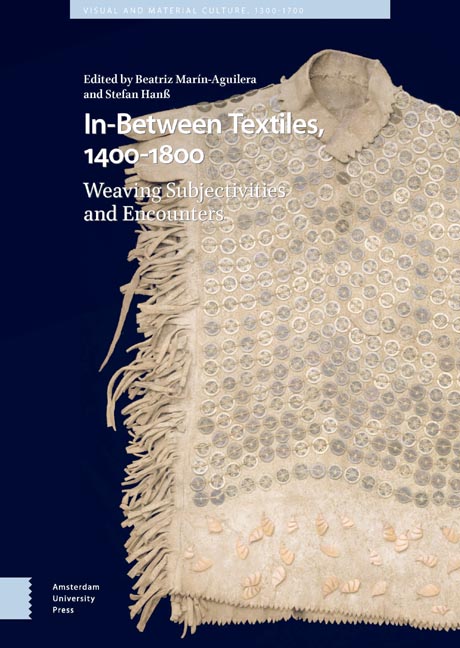Book contents
- Frontmatter
- Dedication
- Miscellaneous Frontmatter
- Table of Contents
- List of Illustrations
- Acknowledgements
- 1 Subjectivities In-Between Early Modern Global Textiles
- Part I Unhomeliness, Mimicry, and Mockery
- Part II The Material Enunciation of Difference
- Part III Identity Effects In-Between the Local and the Global
- Part IV Material Translation and Cultural Appropriation
- Archives, Libraries, and Museums (Abbreviations)
- Select Bibliography
- Index
14 - The Material Translation of Persian and Indian Carpets and Textiles in Early Modern Japan
Published online by Cambridge University Press: 14 October 2023
- Frontmatter
- Dedication
- Miscellaneous Frontmatter
- Table of Contents
- List of Illustrations
- Acknowledgements
- 1 Subjectivities In-Between Early Modern Global Textiles
- Part I Unhomeliness, Mimicry, and Mockery
- Part II The Material Enunciation of Difference
- Part III Identity Effects In-Between the Local and the Global
- Part IV Material Translation and Cultural Appropriation
- Archives, Libraries, and Museums (Abbreviations)
- Select Bibliography
- Index
Summary
Abstract
This chapter argues that Persian and Indian carpets and textiles helped negotiate new signs of identity in Edo Japan. It is argued that practices of commercial exchange, gift-giving, diplomacy, and ceremonial as well as spiritual aesthetics channelled the translation of textiles and carpets in-between the Indian subcontinent and the islands of Japan. These carpets crossed borders and, by doing so, they defined and negotiated cultural connections. When arriving in Japan, acts of cultural translation were required to ensure the acceptance of such in-between textiles. When translated into Edo society, Indian and Persian carpets could stage hierarchies, legitimise authority, embody wealth, and materialise Japanese spiritual and symbolic aesthetics.
Keywords: Indian textiles; carpets; Edo Japan; material translation; Dutch East India Company
Introduction
In pre-modern Japan, woollen fabrics were uncommon due to the country’s humid climate and the absence of sheep. Recent research has revealed, however, that despite Japan’s seclusion policy from the seventeenth till the nineteenth century, a number of Indian carpets was brought to Japan by the Dutch East India Company (VOC) during exactly that period. Still today, Japan holds a total of three starmedallion Indian carpets from the eighteenth century. This type of carpet was often depicted in seventeenth-century Dutch paintings but there are no extant examples elsewhere. Moreover, a star-medallion Indian carpet has recently been discovered in Kyoto (Fig. 14.1).
As discussed in this chapter, the Dutch presented Indian and Persian carpets as gifts to Japanese rulers and elites to maintain good relations from the seventeenth century onwards. Such imported gifts circulated exclusively among a limited number of people such as shoguns and other elites. Rulers, high officials, and powerful merchants enjoyed the privilege of using carpets from overseas. From the eighteenth century onwards, however, a larger variety of people across the social spectrum was able to get access to Indian and Persian carpets. Since the mid-eighteenth century, wealthy Kyoto merchants decided to use imported Indian carpets also as covers for the floats of the Kyoto Gion Festival (Fig. 14.2). This annual festival, which originated in the tenth century to protect people from the plague, celebrates the Yasaka Shrine in Kyoto. From the fourteenth century onward, when merchants increased their economic power, those residing in the Shimogyo area in Kyoto organised parades of large floats on the occasion of the Gion Festival each June.
- Type
- Chapter
- Information
- In-Between Textiles, 1400-1800Weaving Subjectivities and Encounters, pp. 305 - 326Publisher: Amsterdam University PressPrint publication year: 2023



